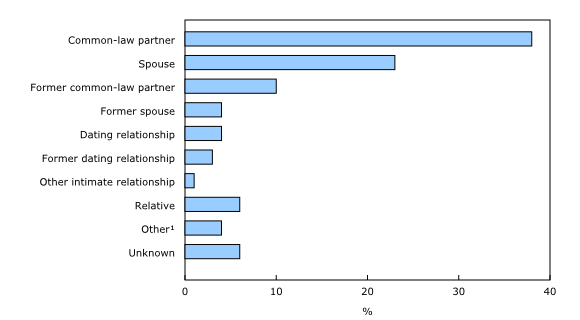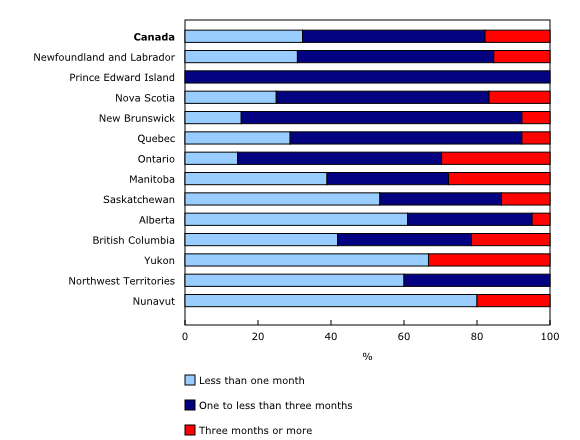Canadian residential facilities for victims of abuse, 2017/2018
Archived Content
Information identified as archived is provided for reference, research or recordkeeping purposes. It is not subject to the Government of Canada Web Standards and has not been altered or updated since it was archived. Please "contact us" to request a format other than those available.
Released: 2019-04-17
In 2017/2018, there were 552 facilities operating across Canada which had a primary mandate to serve victims of abuse, and these facilities admitted over 68,000 people. Residential facilities for victims of spousal and interpersonal violence have been providing an essential service since the 1970s.
Almost all (99.9%) of the admissions to residential facilities in 2017/2018 were women (60.3%) and their accompanying children (39.6%). A small number of these facilities, a total of 15 or 3%, also served men. In all, facilities admitted 86 men in 2017/2018.
On the snapshot day of April 18, 2018, there were 3,565 women, 3,137 children, and 8 men residing in residential facilities for reasons of abuse.
According to the latest self-reported data on victimization, equal proportions of men and women reported having been a victim of spousal violence during the preceding five years (4%, respectively). Women were nearly twice as likely to have experienced the most severe types of spousal violence as men.
A Juristat article focused on the characteristics of Canadian residential facilities for victims of abuse and their residents is now available. The article, "Canadian residential facilities for victims of abuse, 2017/2018," uses data from the first iteration of the Survey of Residential Facilities for Victims of Abuse, as does the accompanying infographic "Residential facilities for victims of abuse in Canada, 2017/2018." This survey is a redesign of the Transition Home Survey, which was last conducted in 2014.
Abuse by a current or former intimate partner was the most common reason for admittance to the facilities
Of the 3,565 women who resided in facilities and reported abuse as their primary reason for seeking shelter on snapshot day, 66% identified a current intimate partner as their abuser, while 18% identified a former intimate partner. Intimate partners include individuals who are or were legally married, common-law, dating or who are or were in other types of intimate relationships.
About one in five women leaving a residential facility return to live with their abuser
Among the women who left a residential facility on snapshot day, 21% said they were returning to a residence where their abuser continued to live. For an additional 36% of women who left on that day, either they or the facility did not know where they were going upon departure. Other women reported they would be living with friends or relatives (18%), or entering another residential facility for victims of abuse (11%). The remaining 14% of women had other plans, such as returning home or moving to a new residence without their abuser.
More than one-third of short-term residential facilities for victims of abuse were full on snapshot day
In Canada in 2018, 428 facilities offered short-term accommodation for victims of abuse. Short-term facilities are those with an expected length of stay of less than three months. Nationally, 36% of these short-term residential facilities were considered full on snapshot day, meaning 90% or more of their beds were occupied. Among the provinces, Saskatchewan reported the highest percentage of short-term facilities that were full (47%), followed by Quebec (43%), British Columbia (43%) and Ontario (42%).
In general, short-term facilities in urban areas were more likely to be reported full (41%) than similar facilities in rural areas (29%).
Across Canada, there were 6,500 funded beds in short-term residential facilities in 2018. Funded beds are those that officially exist due to funding typically from government sources and exclude temporary sleeping arrangements such as cots, sofas or sleeping bags. Over three-quarters (78%) of these funded beds were reported occupied on snapshot day. Among the provinces, Quebec (90%), Ontario (84%) and Saskatchewan (78%) reported the highest proportion of occupied beds. In the territories, 98% of 120 funded beds in short-term facilities were occupied.
While the occupancy rate was consistently higher in urban (83%) than rural (67%) short-term facilities, there were three exceptions. These exceptions were Manitoba, where the occupancy rate was 23% in urban facilities versus 58% in rural facilities, as well as Saskatchewan at 75% occupancy in urban facilities compared with 86% in rural facilities. In addition, Newfoundland and Labrador reported an occupancy rate of 48% in urban facilities versus 53% in rural facilities.
A full residential facility is the most common reason for turning away victims seeking shelter
On snapshot day, 669 women, 236 accompanying children, and 6 men were turned away from residential facilities for victims of abuse. The most common reason reported for a woman being turned away was that the facility was full (82%). Other reasons for turning away a woman included the individual's profile being outside of the facility's mandate (8%), a safety issue for the facility (for example, the individual was on a non-admit or caution list) (2%), and the type of abuse experienced is outside the facility's mandate (2%).
Short-term residential facilities for victims of abuse in Ontario and Manitoba report longer average lengths of stay
Typically, short-term facilities are mandated to provide shelter for a stay less than three months. For 18% of short-term facilities in Canada, the average length of stay exceeded the mandated maximum of three months. Among the provinces, 30% of short-term facilities in Ontario reported average lengths of stay of three months or longer, as did 28% of facilities in Manitoba.
Two of the top challenges facing facilities and their residents, which may help explain extended stays, were a lack of permanent housing (reported by 38% of facilities), and a lack of affordable and appropriate long-term housing options upon departure from residential facilities (reported by 77% of facilities on behalf of their residents).
Indigenous and non-permanent resident women and children overrepresented in residential facilities for victims of abuse
Indigenous women (First Nations, Métis and Inuit) were overrepresented in residential facilities for victims of abuse by approximately five times their representation in the Canadian population. Similarly, Indigenous children were overrepresented by approximately three times their representation in the Canadian population. More than one in five (22%) women and one-quarter of children (25%) residing in facilities for victims of abuse were Indigenous. At the same time, Indigenous women accounted for 4% of Canadian women aged 18 and older, while Indigenous children comprised 8% of Canadian children 17 and under.
According to data from the most recent General Social Survey (GSS) on Canadians' Safety (Victimization), Indigenous females had an overall rate of self-reported violent victimization that was nearly triple that of non-Indigenous females. As well, Indigenous women were more likely than non-Indigenous women to be a victim of spousal violence in the five years that preceded the GSS on Victimization.
Non-permanent residents in Canada are also overrepresented in residential facilities for victims of abuse. Of the women in residential facilities whose residency status was known, 9% were non-permanent residents, a rate six times higher than their representation in the Canadian population (1.5%). Nationally, 8% of accompanying children were non-permanent residents, compared with 0.9% of the general population. Non-permanent residency often carries additional barriers to accessing affordable and safe housing, including lower income, less stable housing and employment, financial interdependence, and a lack of awareness of available services.
Note to readers
This Juristat article uses data from the Survey of Residential Facilities for Victims of Abuse (SRFVA). The SRFVA collected annual (2017/2018 fiscal year) and snapshot day (April 18, 2018) information on residential facilities in Canada that are primarily mandated to serve victims of abuse.
Facilities were asked to report the type of facility they operated based on the expected length of stay provided for in their service mandate, regardless of practice. They were grouped into two categories:
Short-term residential facilities include those with a general policy of providing accommodation for less than three months and typically provide individual beds to residents.
Long-term residential facilities include those with a general policy of providing accommodation for three months or more and typically provide residential units (for example, apartments or houses) to residents.
The SRFVA is a redesign of the Transition Home Survey (THS), which was conducted every two years from 1993 through 2014. Due to differences in survey scope and content, data collected for the SRFVA are not comparable with historical THS data.
Other intimate partners include people who had a sexual relationship or a mutual sexual attraction but to which none of the other relationship options apply. This can include "one-night stands" or brief sexual relationships.
An urban area is defined as a census metropolitan area (CMA) or a census agglomeration (CA). Rural areas are all areas outside of CMAs and CAs.
Population data for Indigenous and non-permanent resident populations in Canada are based on 2016 Census of Population estimates from the long-form census questionnaire. Readers should be aware that the universe for the long-form census questionnaire is the population in private households only, which excludes persons in collective dwellings. Additionally, while every attempt has been made by the Census to enumerate non-permanent residents, there are factors (for example, not being aware of the need to participate) which may have affected the estimate of this population. Previous coverage studies have indicated that the non-permanent resident population was missed at a higher proportion than the general population.
Products
The article "Canadian residential facilities for victims of abuse, 2017/2018" is now available as part of the publication Juristat (85-002-X). The infographic "Residential facilities for victims of abuse in Canada, 2017/2018" (11-627-M) is also released today.
Additional data are available upon request.
Contact information
For more information, or to enquire about the concepts, methods or data quality of this release, contact us (toll-free 1-800-263-1136; 514-283-8300; STATCAN.infostats-infostats.STATCAN@canada.ca) or Media Relations (613-951-4636; STATCAN.mediahotline-ligneinfomedias.STATCAN@canada.ca).
- Date modified:



